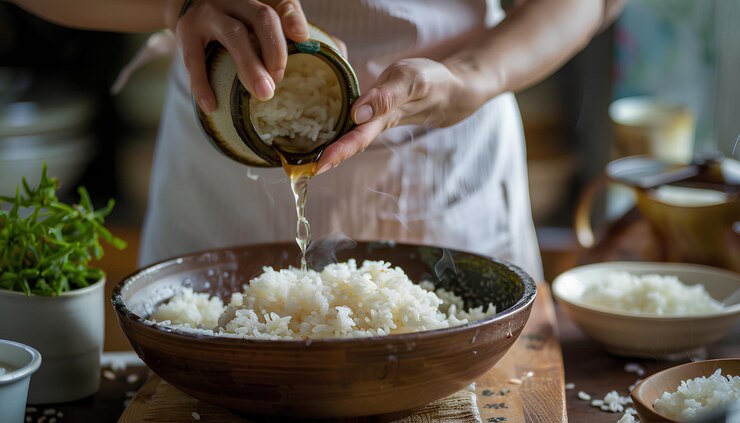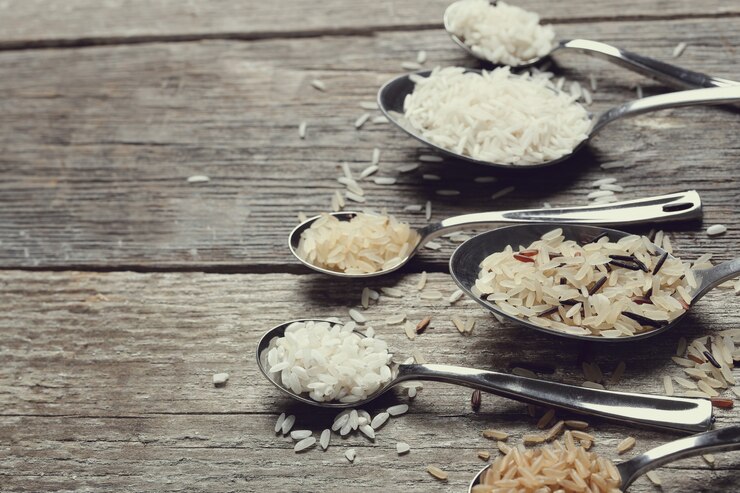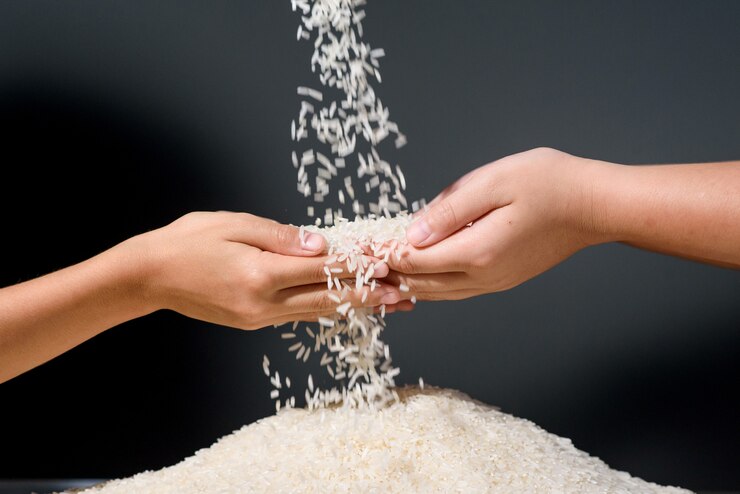Is your rice turning out mushy and disappointing? Don’t worry, you’re not alone! This common cooking mishap can be easily fixed with a few simple tricks. Whether you’ve cooked your rice on the stove, in a rice cooker, or even in the microwave, we’ve got you covered. In this guide, we’ll explore various methods to rescue your mushy rice, from using bread to adding salt, and even baking it in the oven.
So, why is your rice turning out sticky and mushy? What mistakes are you making? And how can you prevent it from happening again? Keep reading to discover the secrets to perfect rice, every time. We’ll delve into common reasons for mushy rice and provide step-by-step instructions to revive it. Whether you’re a seasoned cook or a kitchen newbie, this guide will help you achieve fluffy, delicious rice that will elevate your meals.
1. Too Much Water
Adding too much water to your rice can lead to a mushy, clumpy mess. The excess liquid prevents the grains from cooking evenly and absorbing the flavors of your dish.
How to Avoid Overwatering: Use a measuring cup to ensure precise water-to-rice ratios. Rinsing rice before cooking can help remove excess starch, which can contribute to stickiness. Keep the lid on while cooking to trap steam and prevent moisture loss.
Fixing Overwatered Rice: If you notice too much water while cooking, carefully drain off the excess. Spread the wet rice on a baking sheet and bake in a low-temperature oven to evaporate excess moisture. Add the overcooked rice to soups, stews, or fried rice to utilize it effectively.
By following these tips, you can avoid the pitfalls of overwatering and achieve perfectly cooked rice every time.

2. Wrong Pot Usage
The type of pot you use can significantly impact the outcome of your rice. A wrong choice can lead to uneven cooking, sticking, and a mushy texture.
Why Pot Choice Matters: A good pot should distribute heat evenly to ensure consistent cooking. Certain materials, like clay or cast iron, can absorb and retain heat, which is ideal for rice cooking. A tight-fitting lid helps trap steam and moisture, leading to fluffy rice.
Tips for Choosing the Right Pot:
- Consider a Rice Cooker: These specialized appliances are designed to cook rice perfectly.
- Opt for a Thick-Bottomed Pot: This ensures even heat distribution and prevents scorching.
- Avoid Nonstick Pans: While nonstick pans are convenient, they may not be the best choice for rice as they can hinder the formation of a crispy bottom layer.
By selecting the right pot, you can significantly improve the quality of your rice and elevate your culinary experience.
3. Not Tailoring Water to Rice Type
Different types of rice require varying amounts of water. Neglecting this detail can result in either undercooked or overcooked rice.
- Short-Grain Rice: This type of rice, often used in sushi, requires more water as it has a higher starch content.
- Medium-Grain Rice: A popular choice for many dishes, medium-grain rice typically needs a 1:1 ratio of rice to water.
- Long-Grain Rice: This type of rice, common in many Asian cuisines, requires less water as it has a lower starch content.
Most rice packages provide specific cooking instructions, including water measurements. Don’t be afraid to experiment and adjust the water amount based on your preferred texture. Higher altitudes can affect cooking times, so you may need to add a little more water.
By understanding the specific needs of different rice varieties, you can consistently achieve perfectly cooked rice.

4. Not Setting the Right Temperature
The temperature at which you cook your rice can significantly impact its texture. Too high a temperature can lead to scorching and a burnt taste, while too low a temperature can result in undercooked, mushy rice.
Ideal Temperature Range: Aim for a medium-low heat setting. This allows the rice to cook slowly and evenly, absorbing the water gradually. Most modern rice cookers have automatic temperature settings, but you can often adjust them for specific rice varieties.
Tips for Optimal Temperature Control: High heat can cause the rice to stick to the bottom of the pot and burn. Keep an eye on the rice as it cooks to ensure it’s not overcooking or undercooking. A kitchen thermometer can help you accurately measure the temperature of the cooking liquid.
By carefully controlling the temperature, you can achieve perfectly cooked rice that is fluffy, flavorful, and enjoyable.
5. Overcooking
Overcooking is one of the most common reasons for mushy rice. When rice is cooked for too long, the grains absorb excess water, becoming soft and losing their distinct texture.
Signs of Overcooked Rice:
- Mushy texture
- Loss of individual grains
- A pasty appearance
Preventing Overcooking:
Set a Timer: Use a timer to monitor cooking time and avoid overcooking.
Check for Doneness: Once the rice has absorbed most of the water, turn off the heat and let it sit for a few minutes. This allows the remaining moisture to be absorbed.
Avoid Stirring Frequently: Stirring too often can break the grains and lead to a mushy texture.
By being mindful of cooking times and avoiding overcooking, you can ensure that your rice is perfectly cooked and delicious.

Additional Tips To Fix Your Mushy Rice
Here are additional techniques that can help you avoid mushy rice:
Rinsing Rice
Rinsing rice before cooking can significantly impact its texture and flavor. By rinsing, you remove excess surface starch, which can lead to a fluffier, less sticky result. This is particularly beneficial for long-grain rice, where distinct grains are desired. However, for short-grain rice, some starch is essential for creating a creamy, cohesive texture, so rinsing may not be ideal.
Additionally, while rinsing can help remove impurities and off-flavors, it can also wash away some of the rice’s natural nutrients and flavor compounds. The extent of this impact depends on the rinsing method and the type of rice. Ultimately, the decision to rinse or not depends on the specific recipe and desired outcome.
| Feature | Pros | Cons |
| Texture | Rinsing removes excess starch, leading to fluffier, less sticky rice. | Rinsing can remove some of the natural starch, which can affect the desired texture for certain dishes like risotto. |
| Flavor | Rinsing can help remove any impurities or off-flavors. | Rinsing can also wash away some of the rice’s natural nutrients and flavor. |
| Cooking Time | Rinsing can slightly reduce cooking time as the excess starch is removed. | Minimal impact on cooking time. |
| Health | Rinsing can help reduce the amount of arsenic, a naturally occurring toxin, in rice. | Rinsing can also reduce the amount of essential nutrients like vitamins and minerals. |
Note: The decision to rinse rice before cooking depends on your personal preference, the type of rice, and the desired texture and flavor.
To effectively rinse rice, use a fine-mesh strainer and cold water. Place the rice in the strainer and gently agitate it under running water until the water runs clear. Avoid rubbing the rice grains together too vigorously, as this can damage them.
For sticky rice varieties, you may need to rinse multiple times to remove excess starch. Once rinsed, drain the rice thoroughly before cooking. By following these simple steps, you can ensure that your rice is properly rinsed and ready to cook.
The Role of Starch in Rice Texture
Starch plays a crucial role in determining the texture of cooked rice. Amylose and amylopectin are the two main types of starch found in rice. Amylose is responsible for the firm, fluffy texture of long-grain rice, while amylopectin contributes to the sticky, cohesive texture of short-grain rice. During cooking, starch granules absorb water and swell, leading to the gelatinization process.
The degree of gelatinization affects the final texture of the rice. Overcooking can lead to excessive gelatinization, resulting in a mushy texture. By understanding the role of starch, you can control the cooking process and achieve the desired texture for your rice dish.
| Rice Type | Starch Content | Texture |
| Short-Grain Rice | High in amylopectin | Sticky, soft, and chewy |
| Medium-Grain Rice | Balanced amylose and amylopectin | Slightly sticky, firm, and fluffy |
| Long-Grain Rice | High in amylose | Fluffy, dry, and separate grains |
Note: The starch content in rice can vary depending on the specific variety and growing conditions.
To manage starch content and achieve your desired rice texture, soaking rice in water for 30 minutes to an hour can help reduce cooking time and create a more tender texture.
Storing Cooked Rice
To properly store cooked rice and prevent it from drying out or becoming mushy, follow these steps:
- Quick Cooling: Transfer hot cooked rice to a shallow, airtight container to cool it rapidly. This reduces the risk of bacterial growth.
- Refrigeration: Once cooled, store the rice in an airtight container in the refrigerator. This will help maintain its moisture content and prevent spoilage.
- Freezing: For longer storage, you can freeze cooked rice. Transfer it to a freezer-safe container, pressing out excess air to minimize freezer burn.
- Reheating: When reheating, add a splash of water or broth to prevent the rice from drying out. Reheat thoroughly on the stovetop, in the microwave, or in the oven.
By following these guidelines, you can enjoy delicious, fresh-tasting rice even after it has been stored.
| Storage Method | Best Containers | Benefits | Drawbacks |
| Refrigeration | |||
| Short-Term (3-4 Days) | Airtight glass or plastic containers, resealable bags | Maintains moisture and flavor, prevents bacterial growth. | Can affect the texture slightly. |
| Freezing | |||
| Long-Term (Up to 3 Months) | Freezer-safe bags, airtight containers | Preserves rice for extended periods. | Can affect texture, especially after multiple freeze-thaw cycles. |
To reheat rice and maintain its texture and flavor, consider these methods:
- Microwave Method: Add a splash of water or broth to the rice before reheating. Cover with a damp paper towel to create steam and prevent the rice from drying out. Microwave in 30-second intervals, stirring in between, to ensure even heating. Fluff the rice with a fork to separate the grains.
- Stovetop Method: Add a few tablespoons of water or broth to the rice. Heat the rice over low heat, covered, until it is warmed through. Stir gently to prevent sticking and ensure even heating.
By following these tips, you can enjoy perfectly reheated rice that tastes just as good as freshly cooked.
Final Thoughts
By following these tips and tricks, you can elevate your rice game and create delicious, flavorful meals. Remember, the key to perfect rice lies in attention to detail, from choosing the right type of rice to mastering the cooking techniques. So, the next time you cook rice, don’t hesitate to experiment and find what works best for you. Happy cooking!
FAQs
How do you fix rice that is too mushy?
If your rice is slightly mushy, spread it on a baking sheet and let it dry in a low oven or air fryer. For very mushy rice, consider adding it to a stir-fry or soup to absorb excess moisture.
Can mushy rice be saved?
Yes, mushy rice can often be saved. The best method depends on the severity of the mushiness. For mild cases, drying it out can restore its texture. For more severe cases, incorporating it into other dishes like fried rice or risotto can be effective.
Can you make rice soft again?
While you can’t directly make mushy rice soft again, you can prevent it from becoming mushy in the first place by following proper cooking techniques. Avoid overcooking, use the right amount of water, and consider rinsing the rice before cooking.
How do you dry out rice?
To dry out mushy rice, spread it on a baking sheet and place it in a low-temperature oven or air fryer. You can also let it air dry, but this process may take longer. Once the rice is dry, you can use it in various dishes or store it for future use.









